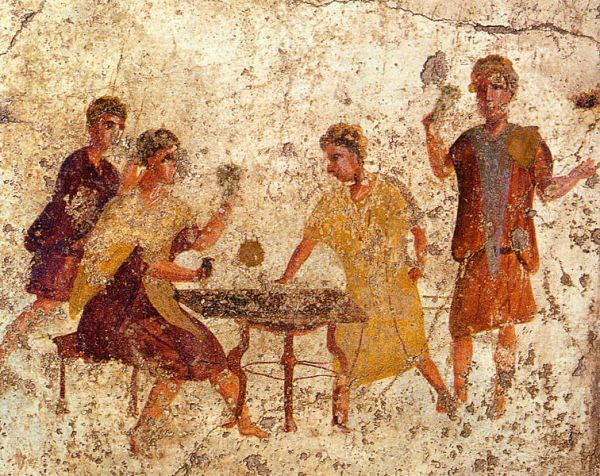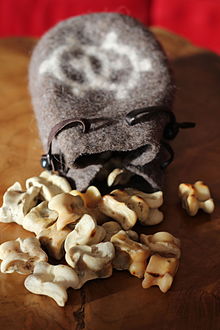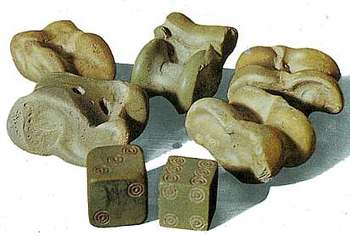Okay, I will slide it for you.
I have been thinking their crap tweets are how they communicate with other DS buddies, just like holding up that stupid okay eye sign, saying "I'm in the club."
So if it is a possibility these morons are communicating in code/symbolism to each other I thought maybe I would be able to find something "dog" related that could be meaningful to them but would not occur to us "normies."
With things Q I tend to come at drops, tweets, etc from the frame of reference that most always includes Egypt (Nimrod/Mason)and Rome because their symbolism will be their downfall.
So I found this.
"Dice were called alsae by the Romans, and there were two kinds, the tali, or four-sided knuckle-bones (animal) and the tesserarae or six-sided bones. The tali has four sides long-wise, the two ends were not regarded. Up one side there was an ace, or canis (dog)on the opposite side six; on the other two sides four and three. On the tessararae the numbers were from one to six. But on both sides of the alsae or dice the numbers on the upper and lower side would make seven, as now-a-days on dice."
"The game was played with three tessararae and four tali. They were put into a box made into the form of a tower, with a straight neck-wider below than above, called fritillas,turris, turricula, orca, etc. This box was shaken, and the dice was thrown upon the gaming board, forus, alvenus, tabulus, oriae. The highest or most fortunate throw was called Venue, or jactus venereus, or basilicus (the King's throw.) It consisted of three sixes on the terresarae, and differing numbers, as two alike, on the tali."
"The worst throw, the dog throw, was called in Latin jactus pessimus, or jactus canes. In this throw, the three tesserarae must be aces, and the tali all the same number."
https://books.google.com/books?id=zlhOAQAAMAAJ&pg=PA87&lpg=PA87&dq=In+ancient+times+the+dog+was+the+worst+throw+in+dice&source=bl&ots=ljUMZnZWr4&sig=ACfU3U07eVPEHq6K2-Eq8FVubx4fGVCepw&hl=en&sa=X&ved=2ahUKEwji9JOXxsbhAhUHc98KHUcDAOgQ6AEwCHoECAkQAQ#v=onepage&q=In%20ancient%20times%20the%20dog%20was%20the%20worst%20throw%20in%20dice&f=false
pages 87-88
To me the symbolism in the tweets could be they gambled with their life/freedom/racket in this game of dice with 45, they rolled a "dog throw" and their dog died.
Maybe they are telegraphing to others their fate in the Game of Thrones.
Or maybe life is a cartoon and we are in the funny papers.
Oh I almost forgot the stamped dog tag relative to the dog theme.
A signaculum was a lead "dog tag" in a leather pouch carried by Roman soldiers around their neck. It seems to have had personal details (acting to identify a body the same way a modern dog tag does) with a seal or stamp to authenticate it.
Mark of slaves
Slaves were also known to wear dog tags on their person, typically in the form of an unremovable metal collar that would be inscribed with messages such as:
If you find this slave, he has run away. Please return him to his owner at the following address. You will be rewarded.
These, along with branding and tattooing, were common ways for Roman slaves to be separated from the rest of the Roman social system, and easily punishable should they make their escape.
Signaculum also describes the stamps on some Roman Imperial goods, and are used to identify the manufacturer and/or other pertinent facts about the item.
https://en.wikipedia.org/wiki/Signaculum
ROLLING BONES
In the first millennium BC, civilizations thrived in Greece, India, and China- and they all threw dice. In Rome, it was common for gamblers to call out the goddess Fortuna’s name while rolling a 20-sided die during a game of chance. But they had to do it quietly -dice games were illegal in Rome (except during the winter solstice festival of Saturnalia). Not that that stopped anyone from playing it: One surviving fresco depicts two quarreling dicers being thrown out of a public house by the proprietor. * When General Julius Caesar led his army across the Rubicon River to attack Rome in 49 BC -which set in motion his rise to power- he knew that there was no turning back, proclaiming, ”Lea iacta est.” Translation: “The die is cast.”

http://carolinanaturally.blogspot.com/2014/08/rollin-bones.html
Bone and Dice Divination: The Art of Astragalomancy
Astragalomancy, meaning divination by dice, is a compound word derived from the ancient Greek astragalos, meaning a bone from the vertebrae, or when in the plural, astragali, a dice or knuckle bone; and manteia, meaning prophesy or divination. The confluence between dice and bone makes sense because the ancient Greeks made their dice from sheep knuckles. A related term, astragyromancy, comes from the Greek word gyromancy, which suggests divination performed by the spinning of a dice. Both of these terms are actually subsets of the larger discipline of cleromancy, which is divination by the process of sortition, or casting lots.
Sortition was an important concept in the ancient world, especially in Greece and Rome where the casting of lots was used to to select government officials. Sortition was considered by the Greeks to be a purer, less corruptible form of democracy than holding elections. It had in the past at times been popular to believe that casting lots indicated the will of the gods. Included amongst possible items used to conduct the process, were marked sticks and pebbles.
There are numerous instances of the casting of lots in the Bible..
https://www.metaphysicalityinc.com/2016/09/bone-dice-divination.html
The game of Hounds and Jackals was important to Egyptians who lived during the Middle Kingdom (approximately 4,000 years ago). Egyptologists know this because they have found many examples of these game boards at Middle Kingdom archaeological sites. This game is usually found in tombs, which might tell us that the game was not only played because it was fun, but also because it had a symbolic meaning.
The ancient Egyptians believed in an afterlife, which means existence after death. To have a good afterlife, a person who died would have to complete certain rituals to please the gods and enter the underworld. We know that some games represented a successful trip to the afterlife, so the game of Hounds and Jackals could have represented the journey to the afterworld, too. The player who reached the shen sign may have not only won the game, but also successfully completed the transition from this life to the next.


Bone and Dice Divination: The Art of Astragalomancy
https://www.metaphysicalityinc.com/2016/09/bone-dice-divination.html


https://www.historicgames.com/learnmore/knuckstats.html




